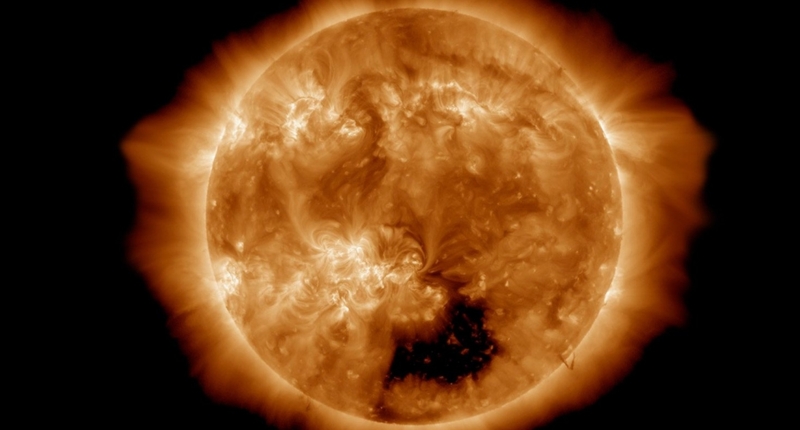A massive coronal hole, the size of thirty Earths, has opened up in the Sun, and the phenomenon is controlled by the National Oceanic and Atmospheric Administration (NOAA). The solar storm is expected to produce the brightest northern lights in unusual latitudes this weekend, and it is likely to hit our planet with an average intensity of the storm. However, scientists believe that its main effect will be limited to the appearance of the northern lights. The stream of solar particles blasted into space at high speed is running with winds of over 2 million kilometers per hour, and it could cause electronic devices to malfunction, leading to power outages and triggering geomagnetic storms. The effects of the storm were already noticeable on Friday and continued through Saturday. Though the solar storm may be spectacular, experts suggest that it is not expected to take a significant toll. The Sun is expected to increase its activity as it approaches maximum, and NASA’s Solar Dynamics Observatory (SDO) recently detected a giant “tornado” over the Sun’s north pole.
Giant Coronal Hole in the Sun Produces Northern Lights in Unusual Latitudes
A new massive coronal hole in the Sun, the size of thirty Earths, has recently opened up. This phenomenon, which is controlled by the National Oceanic and Atmospheric Administration (NOAA), is expected to produce the brightest northern lights in unusual latitudes. On the coming weekend, a large number of charged solar particles that fall under the category of G1 and G2 geomagnetic storms are expected to hit our planet, with an average intensity of the storm.
According to the NOAA Space Weather Prediction Center, the speed of the solar particles that have already hit our planet could exceed 600 km/s. While the coronal hole may seem spectacular, scientists suggest that its primary impact will be limited to the appearance of the northern lights in unusual latitudes. Alex Young, a scientist from NASA’s Division of Heliophysical Sciences, explains that the coronal current is between 300,000 and 400,000 kilometers in diameter, and it lines up between 20 and 30 lands one after another.
Coronal holes are cooler and darker areas in the Sun’s atmosphere that are not true empty holes. When these holes open up in the corona, they allow a greater stream of charged particles to flow, which we know as the solar wind. The stream of particles was blasted into space at high speed, and according to the National Oceanic and Atmospheric Administration, the hole is running with winds of over 2 million kilometers per hour.
While these particularly strong geomagnetic storms can cause electronic devices to malfunction and even lead to power outages, the current phenomenon is not expected to take a significant toll. Moreover, as the Sun approaches its maximum (expected 2025), it increases its activity. For instance, NASA’s Solar Dynamics Observatory (SDO) recently detected a giant “tornado” over the Sun’s north pole.
Scientists have observed the Sun’s boiling plasma rising above its surface, reaching a maximum height of 14 Earths, about 120,000 kilometers, on March 18. Two days later, a huge coronal hole appeared. The effects of the storm were already noticeable on Friday and continued through Saturday.
In conclusion, the appearance of a gigantic coronal hole in the Sun, controlled by NOAA, will cause the brightest northern lights in unusual latitudes. Though this phenomenon might be spectacular, its primary effect will be limited to the appearance of the northern lights. Scientists confirm that the current solar storm is not expected to have a significant impact.
Don’t miss interesting posts on Famousbio










